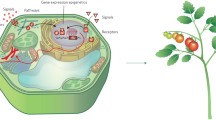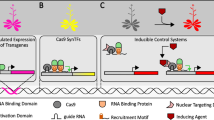Abstract
Signal transduction is used by plants to coordinate their development and to sense and respond to fluctuations in their surroundings. Of prime importance is the ability to defend against pathogens and other environmental hazards such as cold temperatures, drought or wounding. Many transduction pathways are now characterized and the underlying genes are known. This suggests an obvious question—can we engineer signal transduction mechanisms for plant improvement? We address this question by presenting a rationale for an engineering approach and by discussing results from recent attempts to apply this approach. Calmodulin-like domain protein kinase (CDPK) and mitogen-activated protein kinase (MAPK) pathways are used as primary examples. New technology that will aid these efforts is also covered.
Similar content being viewed by others
References
Aharon GS, Gelli A, Snedden WA and Blumwald E (1998) Activation of a plant plasma membrane Ca2+ channel by TGα1, a heterotrimetic G protein α-subunit homologue. FEBS Lett 424: 17–21.
Baulcombe DC (1999) Fast forward genetics based on virus-induced gene silencing. Curr Opinion Plant Biol 2: 109–113.
Becraft PW (1998) Receptor kinases in plant development. Trends Plant Sci 3: 384–388.
Blumwald E, Aharon GS and Lam CHB (1998) Early signal transduction pathways in plant-pathogen interactions. Trends Plant Sci 3: 342–346.
Bögre L, Ligterink W, Meskiene I, Barker PJ, Heberle-Bors E, Huskisson NS and Hirt H (1997) Wounding induces the rapid and transient activation of a specific MAP kinase pathways. Plant Cell 9: 75–83.
Bouchez D and Höfte H (1998) Functional genomics in plants. Plant Physiol 118: 725–732.
Fang YW, MaCool D, Heppard E, Hainey C and Miao GH (2000) Elucidation of host defense signal transduction pathways using the high throughput yeast two-hybrid screen. Plant and Animal Genome VIII Conference, San Diego, CA, USA January 9–12, 2000.
Gadella TWJ, van der Krogt GNM and Bisseling T (1999) GFP-based FRET microscopy in living plant cells. Trends Plant Sci 4: 287–291.
Gelli A, Higgins VJ and Blumwald E (1997) Activation of plant plasma membrane Ca2+-permeable channels by race-specific fungal elicitors. Plant Physiol 113: 269–279.
Gordon GW et al. (1998) Quantitative fluorescence resonance energy transfer measurements using fluorescence microscopy. Biophys J 74: 2702–2713.
Gupta R, Huang YF, Kieber J and Luan S (1998) Identification of a dual-specificity protein phosphatase that inactivates a MAP kinase fromArabidopsis. Plant J 16: 581–589.
Higgins VJ, Lu H, Xing T, Gelli A and Blumwald E (1998) The gene-for-gene concept and beyond: interactions and signals. Can J Plant Pathol 20: 150–157.
Hirt H (1997) Multiple roles of MAP kinases in plant signal transduction. Trends Plant Sci 2: 11–15.
Hirt H (2000a) Connecting oxidative stress, auxin, and cell cycle regulation through a plant mitogen-activated protein kinase pathway. Proc Natl Acad Sci USA 97: 2405–2407.
Hirt H (2000b) MAP kinase pathways: Molecular plug and play chips of cellular bio-informatics. 6th International Congress of Plant Molecular Biology. Quebec, Canada, June 18–24, 2000.
Huang JF, Teyton L and Harper JF (1996) Activation of a Ca2+-dependent protein kinase involved intramolecular binding of a calmodulin-like regulatory domain. Biochem 35: 13222–13230.
Jonak C, Kiegerl S, Ligterink W, Barker PJ, Huskisson NS and Hirt H (1996) Stress signaling in plants: a mitogen-activated protein kinase pathway is activated by cold and drought. Proc Natl Acad Sci USA 93: 11274–11279.
Kovtun Y, Chiu WL, Zeng W and Sheen J (1998) Suppression of auxin signal transduction by a MAPK cascade in higher plants. Nature 395: 716–720.
Kovtun Y, Chiu WL, Tena G and Sheen J (2000) Functional analysis of oxidative stress-activated mitogen-activated protein kinase cascade in plants. Proc Natl Acad Sci USA 97: 2940–2945.
Ligterink W, Kroj T, Nieden UZ, Hirt H and Scheel D (1997) Receptor-mediated activation of a MAP kinase in pathogen defense of plants. Science 276: 2054–2057.
Miyawaki A et al. (1997). Fluorescent indicators for Ca2+ based on green fluorescent proteins and calmodulins. Nature 388: 882–887.
Romeis T, Piedras P, Zhang S, Klessig DF, Hirt H and Jones JDG (1999) Rapid Avr9- and Cf-9-dependent activation of MAP kinases in tobacco cell cultures and leaves: convergence of resistance gene, elicitor, wound, and salicylate responses. Plant Cell 11: 273–287.
Romeis T, Piedras P and Jones JDG (2000) Resistance gene-dependent activation of a calcium-dependent protein kinase in the plant defense response. Plant Cell 12: 803–815.
Saijo Y, Kinoshita N, Hata S, Kyozuka J, Shimamoto K and Izui K (2000) Overexpression of a single calcium-dependent protein kinase confers both cold- and salt/drought tolerance on rice plants. Plant J 23: 319–328.
Schlessinger J (2000) Novel fluorescent approaches for studying cell signaling in single cells. Nature Biotech 18: 262–263.
Segal AW and Abo A (1993) The biochemical basis of the NADPH oxidase of phagocytes. Trends Biochem Sci 18: 43–47.
Sheen J (1996) Ca2+-dependent protein kinase and stress signal transduction. Science 274: 1900–1902.
Somerville S (2000) Microarray experiments in the study of plant-pathogen interactions and their limitations. 6th International Congress of Plant Molecular Biology. Quebec, Canada, June 18–24, 2000.
Suzuki K and Shinshi H (1995) Transient activation and tyrosine phosphorylation of a protein kinase in tobacco cells treated with a fungal elicitor. Plant Cell 7: 639–647.
Uetz P et al. (2000) A comprehensive analysis of protein-protein interactions in Saccharomyces cerevisiae. Nature 403: 623–627.
Usami S, Banno H, Ito Y, Nishihama R and Machida Y (1995) Cutting activates a 46-kilodalton protein kinase in plants. Proc Natl Acad Sci USA 92: 8660–8664.
Wilson I, Vogel J and Somerville S (1997) Signaling pathways: A common theme in plants and animals? Current Biol 7: R175-R178.
Xing T (1998) Bioinformatics and its impact on plant science. Trends Plant Sci 3: 450.
Xing T (2000) Enhancement of plant disease resistance through manipulation of MAP kinase pathway. 6th International Congress of Plant Molecular Biology. Quebec, Canada, June 18–24, 2000.
Xing T, Higgins VJ and Blumwald E (1996) Regulation of plant defense response to fungal pathogens: two types of protein kinases in the reversible phosphorylation of the host plasma membranes H+-ATPase. Plant Cell 8: 555–564.
Xing T, Higgins VJ and Blumwald E (1997a) Race-specific elicitors ofCladosporium fulvum promote translocation of cytosolic components of NADPH oxidase to the plasma membrane of tomato cells. Plant Cell 9: 249–259.
Xing T, Higgins VJ and Blumwald E (1997b) Identification of G proteins mediating fungal elicitor-induced dephosphorylation of host plasma membrane H+-ATPase. J Exp Bot 48: 229–237.
Zhang S and Klessig DF (1997) Salicylic acid activates a 48-kD MAP kinase in tobacco. Plant Cell 9: 809–824.
Author information
Authors and Affiliations
Corresponding author
Rights and permissions
About this article
Cite this article
Xing, T., Jordan, M. Genetic engineering of plant signal transduction mechanisms. Plant Mol Biol Rep 18, 309–318 (2000). https://doi.org/10.1007/BF02825058
Published:
Issue Date:
DOI: https://doi.org/10.1007/BF02825058




